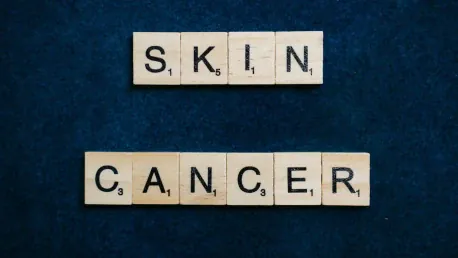The rise in skin cancer cases worldwide has necessitated the exploration of innovative and more efficient treatments. Among the promising solutions is immunotherapy for cancer, a revolutionary method known for its effectiveness. However, this approach is often expensive and may cause severe side effects, which drives the need for more accessible, less toxic alternatives.
Understanding Skin Cancer and Current Treatments
The Prevalence of Skin Squamous Cell Carcinoma (SCC)
Skin squamous cell carcinoma (SCC) stands as the second most prevalent form of skin cancer. It is particularly susceptible to immune responses, even at its precancerous stage, known as actinic keratosis (AK). Treating AK can significantly reduce SCC progression risks. As the world experiences a growing rate of skin cancer incidences, it becomes imperative to find reliable and effective treatment methods for managing AK and preventing its evolution into SCC. Understanding SCC’s susceptibility to immune responses opens the door to innovative therapies such as topical immunotherapy.
SCC is primarily driven by UV radiation exposure, leading to DNA damage and subsequent mutations in skin cells. Treating AK, which presents as rough, scaly patches on the skin, can substantially lower the likelihood of these cells turning malignant. Immunotherapy’s capability to harness the body’s immune system to target and destroy precancerous lesions holds promise in not just mitigating AK but also providing a long-term defense mechanism against SCC.
Existing Treatment Options for Actinic Keratosis (AK)
Present treatment options for AK include topical 5-fluorouracil (5-FU), photodynamic therapy, imiquimod, and tirbanibulin. While these treatments have shown efficacy, only topical 5-FU has demonstrated a temporary reduction in SCC risk, a protection that fades within two years. This transience in effectiveness has propelled the interest in AK immunotherapy as a sustainable strategy. Such treatments function by either directly attacking abnormal skin cells or activating local immune responses to eliminate these cells.
Topical 5-FU, for example, works by interfering with DNA synthesis, leading to cell death. Photodynamic therapy involves applying a photosensitizing agent followed by exposure to a specific wavelength of light, which then destroys affected cells. Imiquimod, on the other hand, boosts local immune response to target abnormal cells, while tirbanibulin disrupts cellular microtubules. Despite their promising results, the temporary nature of 5-FU’s protection against SCC underlines the necessity for more lasting alternatives, making immunotherapy a focal point for future advancements.
The Promise of Calcipotriol and 5-FU Combination
Mechanism of Action
Previous examinations suggest a combination of topical calcipotriol and 5-FU can effectively eliminate AKs. Calcipotriol, a vitamin D analog traditionally used to treat psoriasis, increases thymic stromal lymphopoietin (TSLP) levels in keratinocytes. When combined with 5-FU, this increase is intensified, resulting in a T cell infiltration into AK lesions. This leads to the creation of tissue-resident memory T cells (TRM), giving rise to an enduring immune defense mechanism. The combined therapy leverages calcipotriol’s ability to stimulate a specific immune response and 5-FU’s efficacy in targeting abnormal cells.
This synergistic mechanism not only enhances the treatment’s efficacy but also contributes to long-term protection against AK recurrence and SCC development. The increased infiltration of T cells signifies the body’s enhanced capacity to recognize and remember the precancerous lesions, thereby providing a robust and lasting defense against potential malignancies. This biological pathway has sparked significant interest among researchers aiming to establish a more durable solution for managing precancerous skin conditions.
Study Insights and Methods
The study involved 18 patients treated topically with 0.0025% calcipotriol-plus-2.5% 5-FU twice daily for six days. Diagnoses before and after the treatment were confirmed through clinical and skin biopsy evaluations. Post-treatment, there was notable redness around AKs, which resolved by week 8. The results showed a 95% reduction in AKs on the face, 82% on the scalp, 65% on the right upper limb, and 68% on the left upper limb. These findings underscore the combined therapy’s potential in significantly diminishing the presence of AKs across various regions of the body.
The substantial reduction in AKs observed in this study highlights the therapy’s effectiveness in eliminating precancerous lesions. The clinical and skin biopsy evaluations provide robust evidence supporting the therapy’s capability to transform the skin’s condition. The noticeable post-treatment redness indicates a strong immune response, which then subsides as the lesions are cleared, further demonstrating the treatment’s effectiveness. These promising results pave the way for further exploration and validation of the combined calcipotriol and 5-FU therapy as a long-term preventative measure against SCC.
Biological Pathways and Immune Responses
T## Cell Activation and Immune Pathways
Post-application of calcipotriol-plus-5-FU, a marked increase in AK infiltration by CD4+ T## cells was observed. This infiltration was absent in the normal skin sections. The combination therapy also resulted in an increased number of TRM cells, confirming the predominance of T## cell involvement. Calcipotriol prompts TSLP production, which serves as an immune signal. In combination with 5-FU, it also increases damage-associated molecular patterns (DAMPs) and human leukocyte antigen class II (HLA-II) within premalignant keratinocytes but spares normal skin. This differential effect underscores the targeted nature of the therapy, which selectively enhances immune responses where needed most.
The marked presence of CD4+ T## cells in treated AK lesions signifies a successful activation of immune pathways critical for achieving therapeutic success. The formation of TRM cells indicates a sustained immune vigilance, capable of responding swiftly to any recurrence of precancerous changes. The elevated DAMPs and HLA-II levels within premalignant cells further highlight the dual role of the combination therapy: enhancing immune recognition and destruction of abnormal cells while preserving healthy skin. This selective targeting mechanism is vital in reducing potential side effects and ensuring the treatment’s practicality for widespread use.
T## and IL-24 Axis
The culmination of TSLP promotes CD4+ T## cells to produce interleukin-24 (IL-24). IL-24 triggers toxic cellular processes such as autophagy (self-digestion) and anoikis (loss of cell adhesion), leading to cell elimination. IL-24 also enhances enzymes like MMP-1, which disrupts the membrane separating the epidermis from underlying layers, ultimately causing cell death through apoptosis. This T##-driven immune response is paramount to preventing cancer. Remarkably, T-cell immunity induced by this treatment extends protection against SCC for over five years by targeting AKs.
By facilitating the production of IL-24, the T## and TSLP axis generates potent anti-cancer effects capable of destroying precancerous cells and preventing their malignant progression. The intricate balance of autophagy, anoikis, and apoptosis activated by IL-24 ensures that abnormal cells are effectively eradicated. This protective mechanism extends beyond the immediate treatment period, offering long-lasting defense against the re-emergence of AKs and the potential development of SCC. The sustained T-cell immunity further emphasizes the robustness of the combined calcipotriol and 5-FU therapy as a preventive strategy in skin cancer care.
The Role of T-Cells in Therapy Efficacy
CD4+ T Cells and Their Importance
CD4+ T cells play an indispensable role in the efficacy of calcipotriol-plus-5-FU therapy. They can activate without the need for CD8+ T cells or B cells. Animal models revealed that the absence of CD4+ T cells nullified the benefits of this combined therapy. The synergy between calcipotriol and 5-FU is crucial, as neither component alone is as effective in reducing tumor growth or delaying cancer onset. The presence of CD4+ T cells ensures a coordinated immune response, encompassing initial recognition and persistent defense against potential malignancies.
The ability of CD4+ T cells to drive the therapy’s success independently highlights their central role in immune activation and memory formation. This discovery opens new avenues for developing treatments that focus on enhancing CD4+ T cell responses, thereby ensuring enduring protection against skin cancers. The synergy between calcipotriol and 5-FU underscores the importance of combining different therapeutic mechanisms to achieve superior outcomes in cancer prevention.
Long-Term Protection and Future Implications
The global increase in skin cancer cases has sparked the necessity for innovative and more potent treatments. One of the most promising developments in this field is cancer immunotherapy, a groundbreaking method recognized for its remarkable effectiveness. Immunotherapy works by harnessing the body’s immune system to target and destroy cancer cells. However, despite its potential benefits, this method is not without challenges. It often comes with a high price tag and may lead to serious side effects, making it less accessible and more daunting for many patients. Consequently, there is an ongoing search for alternative treatments that are both affordable and less toxic. This pursuit aims to provide accessible options without compromising effectiveness, ensuring patients can receive necessary care without the associated financial and health burdens. As medical science advances, continued research and innovation are critical in developing these viable alternatives, paving the way for more comprehensive and inclusive cancer treatment strategies.









